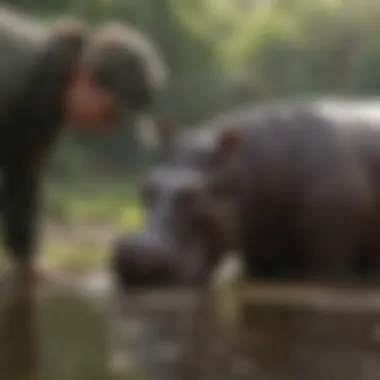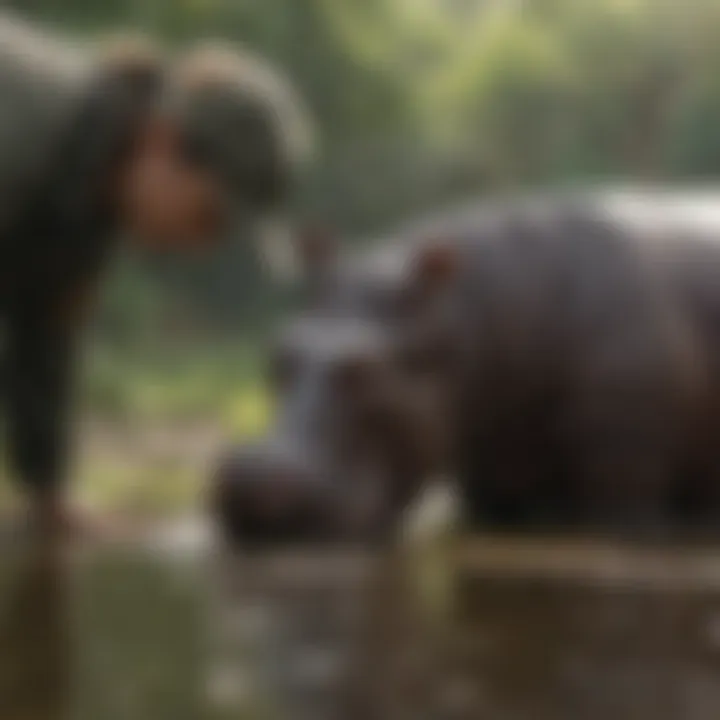Hippo Conservation: Strategies and Challenges Ahead


Intro
The conservation of hippopotamus populations requires a multifaceted approach. Hippos play a crucial role in their ecosystems, yet they face various threats. This article sheds light on key strategies while addressing the challenges in hippo conservation.
Hippos thrive in rivers and lakes across Africa. Their large size and specific habitat needs make them sensitive to environmental changes. For instance, human encroachment leads to habitat loss. Additionally, poaching for meat and ivory contributes to decreasing populations. Understanding these threats is essential for effective conservation practices.
Article Overview
Purpose of the Article
This article aims to provide insights into hippo conservation. It reviews the current state of hippo populations, the ecological significance of these animals, and the threats they face. The goal is to inform readers about ongoing conservation efforts and explore future directions for safeguarding hippos.
Relevance to Multiple Disciplines
Hippo conservation intersects multiple fields—ecology, sociology, and economics. Ecologists study hippos' roles in maintaining river ecosystems. Sociologists examine the human-wildlife conflict near hippo habitats. Economists analyze the impact of tourism on local communities. This interdisciplinary relevance underscores the complexity of conservation efforts.
Research Background
Historical Context
Historically, hippos were abundant across Africa. However, their populations have plummeted due to overhunting and habitat destruction. Conservation initiatives have emerged to address these issues.
Key Concepts and Definitions
- Ecological Role: Hippos maintain the health of aquatic ecosystems. Their grazing patterns affect plant growth in rivers.
- Human-Wildlife Conflict: Increased human activities often lead to encounters with hippos. These conflicts can result in injuries or fatalities.
- Conservation Strategies: Methods like anti-poaching patrols and habitat preservation are vital for protecting hippos.
"Understanding the ecological roles of hippos is vital for effective conservation."
"Understanding the ecological roles of hippos is vital for effective conservation."
The importance of hippos in their habitats cannot be overstated. Conservation strategies must combine scientific research with community engagement to ensure sustainable outcomes. This article thus explores both current approaches and challenges in detail, providing a comprehensive overview for researchers and educators.
Prolusion to Hippo Conservation
The conservation of hippopotamuses plays a critical role in maintaining the balance of ecosystems where they reside. Hippos are not only fascinating creatures but they also serve as key players in their habitats. Understanding their significance and the challenges they face is vital for effective conservation strategies. This article will discuss the various aspects of hippo conservation, highlighting its importance and the multifaceted approaches necessary to protect this species.
Overview of Hippos
Hippopotamuses, native to sub-Saharan Africa, are predominantly found in rivers and lakes. They are recognized for their large size and distinctive appearance, with a massive body, short legs, and a broad mouth. Adult hippos can weigh between 3,000 to 8,000 pounds and measure up to 16 feet in length. Social animals, they often live in groups called pods, which typically consist of females and their offspring, overseen by a dominant male. Hippos are primarily herbivorous, grazers feeding on grasses at night while spending the heat of the day submerged in water to keep cool. Their unique adaptations allow them to thrive in their aquatic environments.
Significance of Hippo Conservation
Conserving hippo populations is vital for several reasons. First, hippos play a significant ecological role. Their grazing behavior helps to manage aquatic plant growth, contributing to nutrient cycling in waterways. Their dung enriches the water with nutrients, promoting biodiversity and supporting various aquatic species. Second, hippos have a cultural significance. They appear in numerous local myths and are a symbol of power and fertility in many African cultures. Protecting hippos means safeguarding cultural heritage.
Additionally, hippos are indicators of freshwater ecosystem health. When their populations decline, it often signals broader environmental issues. Thus, efforts to conserve hippos are not just about protecting this species, but also about preserving the entire ecosystem on which they depend. A comprehensive understanding of these factors is essential to drive effective conservation initiatives.
"Conserving hippos signifies not just species preservation, but the safeguarding of entire ecosystems and cultural heritage."
"Conserving hippos signifies not just species preservation, but the safeguarding of entire ecosystems and cultural heritage."
With the backdrop of their ecological importance and cultural symbolism, hippo conservation demands immediate attention and collaborative effort to ensure their future amid the challenges they face.
The Ecological Role of Hippopotamuses
The ecological role of hippopotamuses is often misunderstood or overlooked. These large mammals are not just a fascinating species to observe; they are crucial components of their ecosystems. Understanding how hippos influence both aquatic and terrestrial environments is essential for appreciating their value in biodiversity and the overall health of ecosystems in which they reside.
Impact on Aquatic Ecosystems
Hippopotamuses play a significant role in aquatic ecosystems, particularly in rivers and lakes across Africa. Their activities contribute to the physical and chemical properties of the water bodies they inhabit. By moving in and out of the water, hippos create and maintain channels that enhance water flow and increase habitat diversity for various aquatic organisms.
Their dung is another vital ecological element. It acts as a nutrient source for fish and other aquatic life, stimulating productivity in nutrient-poor waters. Studies show that hippo-derived nutrients can significantly increase biomass in these ecosystems. This interaction between hippos and aquatic life underscores their role as ecosystem engineers, impacting food webs and promoting biodiversity.
"Hippopotamuses are not just participants in their environments; they actively shape the ecosystems they inhabit."
"Hippopotamuses are not just participants in their environments; they actively shape the ecosystems they inhabit."
Influence on Terrestrial Environments
On land, hippopotamuses also exert a considerable ecological influence. Their grazing habits can modify habitats in significant ways. By consuming large quantities of vegetation near water sources, they directly affect plant species composition. This grazing can promote growth of grasses while limiting other plant types, which in turn affects numerous herbivores and the overall terrestrial biodiversity.


Furthermore, hippos are known to create pathways through dense vegetation. These paths may serve as transit routes for other species, aiding in plant dispersal and providing access for wildlife that would otherwise struggle to navigate such environments. Overall, the influence of hippos extends beyond their presence, as their behavior and activities have cascading effects on both aquatic and terrestrial ecosystems.
The ecological roles of hippopotamuses are multifaceted. Understanding these roles is vital for crafting effective conservation strategies that address not only the needs of hippos but also the integrity of the ecosystems they support. Therefore, protecting hippos essential for maintaining ecological balances in their habitats.
Current Status of Hippo Populations
Understanding the current status of hippo populations is critical in the journey toward effective conservation. Recognizing population dynamics can illuminate both the immediate threats and broader environmental changes that impact their survival. Conserving hippos requires awareness of how their numbers fluctuate and where they can be found. This section will delve into two primary elements: Population Distribution and Conservation Status.
Population Distribution
Geographical Range
The geographical range of hippopotamuses spans a variety of regions in Africa. Hippos primarily inhabit sub-Saharan Africa, often found near water bodies, such as rivers and lakes. Their preference for aquatic environments has shaped their distribution patterns. These water sources are not just habitat; they are vital for their social behavior and feeding habits.
A significant characteristic of the geographical range is its vulnerability due to climate change and human encroachment. This area serves as a beneficial choice for this article as it highlights the interconnectedness between hippos and their ecosystems. The loss of habitats directly affects their survival. While they thrive in some regions, others face drastic reductions in water bodies, affecting the populations.
Moreover, the unique feature of this geographical range is its variability. Some areas, such as the Okavango Delta, provide rich habitats, while regions facing extreme droughts show troubling trends. Each region's advantages and disadvantages reflect in hippo populations, making geographical considerations key to their conservation strategies.
Habitat Preferences
Hippos exhibit distinct habitat preferences that significantly affect their population status. They prefer freshwater habitats, which offer ample foraging options, such as grasslands and riverbanks. These preferences stem from their need for water to maintain body temperature and protect their skin from sunburn.
The key aspect of habitat preferences is their role in determining the viability of hippo populations in varying ecosystems. This understanding is essential for addressing the overall goal of conservation. Regions that provide stable water supply become focal points for conservation efforts. Hence, these areas serve as strongholds for breeding and population recovery, a critical insight for this article.
A unique feature of their habitat preferences is the importance of seasonal water levels. As water levels fluctuate naturally, so do hippo populations. During dry seasons, limited access to water can lead to increased competition among hippos, affecting their health and numbers. Consequently, recognizing these patterns provides a clear framework for developing effective conservation actions.
Conservation Status
IUCN Red List Assessment
The IUCN Red List Assessment offers valuable insights into the conservation status of hippos. Currently, they are classified as Vulnerable. This classification is a crucial factor in understanding the level of threat they face in the wild. The assessment highlights that although some populations remain relatively stable, many others are declining swiftly.
A major highlight of the IUCN Red List is its role as a standardized tool for conservationists. The beneficial nature of this assessment lies in its capability to inform policy and conservation efforts globally. With rigorous data collection, the IUCN facilitates targeted interventions to address specific threats.
The unique aspect of the IUCN status is its adaptability over time. As conservationists implement strategies, ongoing assessments reveal the effectiveness of these measures. This flexibility is an advantage in conservation planning, allowing for real-time adjustments based on new data.
Regional Variations in Population Trends
Exploring regional variations in population trends is critical for understanding hippo conservation fully. Different areas experience varying pressures from human activity, habitat loss, and climate change, leading to significant challenges. These unique regional trends provide insights into the specific measures needed to address population declines.
The key characteristic of these variations is their influence on conservation strategies. Recognizing that hippos are faring worse in some regions than others is beneficial for targeted conservation actions. For instance, populations in East Africa might suffer more from poaching compared to those in Southern Africa that have better protection laws.
A unique feature of assessing these variations is the ability to develop localized approaches. Advantages of a tailored strategy include more efficient allocation of resources and greater community involvement. Understanding regional dynamics informs a comprehensive conservation strategy that balances ecological health with socio-economic needs.
Threats to Hippo Populations
Understanding the threats to hippo populations is crucial for effective conservation. Several factors contribute to the declining numbers of these animals. Each threat has its own importance and impact which we need to analyze carefully. This section explores habitat loss, hunting, poaching, and human-wildlife conflict. Addressing these issues will provide a clearer understanding of the complexities involved in hippo conservation.
Habitat Loss
Deforestation
Deforestation is a major threat to hippopotamus habitats. It results from logging, agriculture, and urban development. As trees disappear, the natural landscape changes, impacting the availability of water resources that hippos need. The loss of riparian zones reduces grazing land as well, compounding the problem. Deforestation also disrupts ecosystems overall and decreases biodiversity.
Key aspects of deforestation include its rapid pace and vast scale in many regions. It sheds light on the urgent need for conservation policies. While deforestation is often pursued for economic growth, its negative consequences far outweigh the temporary benefits. Most notable is its contribution to habitat degradation, leading to loss of hiding and grazing spots.
Mining Activities
Mining activities further exacerbate habitat loss for hippos. Extractive industries often target areas near water bodies. This leads to direct destruction of habitats. The pollutants from mining processes contaminate water sources, risking the health of not only hippos but also other wildlife and local communities.
Mining's unique characteristic is its often irreversible impact on the landscape. It can lead to the creation of pits that make the area inhospitable. Despite potential economic benefits, mining activities represent a significant threat to hippos, emphasizing the trade-off between profit and preservation.
Hunting and Poaching
Commercial Trade
Commercial trade poses a serious threat through illegal hunting and trafficking of hippo products like ivory and meat. This market creates an incentive for poachers to harvest hippos unsustainably. The products can be highly valued and easily sold, leading to increased hunting activities. One key aspect of commercial trade is its international demand, which fuels local poaching.
This trade can quickly drive populations to critical levels, making it a pressing issue. The unique feature of commercial trade is its often hidden nature, making it difficult to track and control. Addressing this requires international cooperation and stringent enforcement of wildlife protection laws.
Subsistence Hunting


Subsistence hunting is another concern, as local communities hunt hippos for food and resources. In many regions, people depend on hippo meat as a protein source. This form of hunting can become problematic when it shifts from traditional practices to more extensive, unsustainable hunting.
The key characteristic of subsistence hunting is its deep-rooted ties to cultural practices. While it may seem less harmful than commercial hunting, its impact can be damaging when coupled with habitat loss and population decline. The challenge remains in balancing the needs of local communities with the necessity of conserving hippo populations.
Human-Wildlife Conflict
Cultural Perceptions
Cultural perceptions greatly influence how communities view hippos. In some cultures, hippos are seen as dangerous animals that threaten agriculture or safety. This perception can lead to negative attitudes and behaviors towards hippos.
One significant aspect of cultural perceptions is their role in shaping wildlife policies. When communities hold negative views about hippos, it is difficult to gain support for conservation initiatives. A challenge in hippo conservation is shifting these perceptions to foster coexistence.
Encroachment on Habitat
Encroachment on habitat occurs as human populations expand into areas traditionally inhabited by hippos. Urbanization, agriculture, and infrastructure development all contribute to this loss of space. Hippos are often forced into smaller areas, leading to overcrowding and stress on their populations.
The key characteristic of encroachment is its direct competition for land and resources. As humans expand their footprint, hippos suffer from habitat fragmentation. This phenomenon leads to isolated populations, making it difficult for hippos to find mates and food. Ultimately, the balance between human development and wildlife conservation must be addressed to secure the future of hippos.
Conservation Strategies for Hippos
Conservation strategies for hippos are crucial given the myriad threats they face. Each strategy aims to mitigate these threats and enhance the chances of survival for these large mammals. Effective conservation requires a multifaceted approach, integrating habitat protection, community involvement, and international cooperation. The success of any conservation plan hinges not only on the implementation of these strategies but also on the ongoing evaluation and adaptation to new challenges.
Protected Areas and National Parks
Establishing protected areas is a primary strategy for hippo conservation. These areas offer habitats free from many human disruptions. The development of national parks specifically for hippos helps preserve their natural environment. Parks such as Kruger National Park in South Africa and Liwonde National Park in Malawi illustrate the effectiveness of creating large reserves. These protected settings can support stable hippo populations by providing essential resources like water and vegetation.
Community-Based Conservation Initiatives
Community involvement is vital for the success of hippo conservation efforts. By engaging local communities, conservationists can promote awareness about the importance of hippos and their role in the ecosystem.
Engaging Local Communities
Engaging local communities allows for better understanding between conservationists and those living near hippo habitats. This engagement encourages locals to participate in conservation programs. A key characteristic of this approach is empowerment. Local people are often the best stewards of their environment; hence, their input can direct effective conservation strategies.
The unique feature of community engagement is its ability to create a sense of ownership over conservation efforts. This foster a greater commitment among local inhabitants to protect hippos. However, challenges can arise due to conflicting interests between local needs and conservation goals.
Benefits of Community Involvement
The benefits of community involvement in hippo conservation extend beyond mere preservation efforts. Such involvement helps create jobs and educational opportunities, which can directly improve the lives of local people. A fundamental aspect of these benefits is sustainability. Sustainable practices ensure that both local populations and hippos thrive together.
Moreover, successful community-led efforts can serve as models globally. Their unique advantages include adaptability to local contexts and the potential for increased public support. However, challenges remain, specifically the need for continuous funding and resources to sustain these initiatives.
International Collaboration and Policy
International collaboration is necessary for successful hippo conservation. Many habitats cross national borders, making cooperation imperative. Effective policies can help safeguard these critical ecosystems through transboundary conservation efforts.
Transboundary Conservation Efforts
Transboundary conservation efforts exemplify collaboration among countries to protect species that inhabit shared ecosystems. A key benefit of this cooperation is cohesive management of wildlife populations. By working together, nations can share resources, knowledge, and strategies to enhance their conservation efforts.
These efforts can create a unified approach to discussions around migration patterns and habitat use. Nevertheless, diplomatic tensions or conflicting priorities can complicate this cooperation, highlighting the need for strong agreements and ongoing dialogue.
Conventions and Agreements
International conventions and agreements play an essential role in conserving hippos. These frameworks provide a standard for countries to follow. They promote best practices and facilitate funding for conservation projects. A key characteristic of such agreements is legally binding commitments. Such commitments may lead to tangible action toward hippo preservation.
Additionally, conventions encourage nations to share data and progress updates, fostering transparency. However, the effectiveness of these agreements can vary, as they often depend on individual countries' willingness to comply and enforce regulations.
By employing these strategies and continuously evaluating their effectiveness, it is possible to create a robust framework for hippo conservation that meets the challenges of today and those of the future.
Emerging Research and Technologies in Hippo Conservation
Emerging research and technologies play a crucial role in Hippo conservation. They offer innovative solutions and improve understanding of the species' ecology and threats. The dynamic nature of conservation challenges demands new approaches. Genetic studies and technological innovations present key opportunities that can enhance our strategies for preserving hippopotamus populations. Significant advancements in these areas can lead to more effective conservation efforts.
Genetic Studies
Population Genetics
Population genetics is an essential area of study for hippo conservation. It examines genetic variations within and between populations. Understanding these genetic structures helps identify critical conservation units. A key characteristic of population genetics is its ability to inform breeding programs and habitat connectivity. This knowledge supports strategies to maintain genetic diversity, which is vital for the long-term resilience of hippos.


The unique feature of population genetics is the use of molecular markers. These markers can track genetic traits and ensure that breeding efforts enhance genetic health. Some advantages include the potential to reduce inbreeding and increase adaptability to changing environments. However, challenges exist. Data collection can be labor-intensive and requires specialized skills, limiting widespread application.
Breeding Programs
Breeding programs are critical for maintaining healthy hippo populations. These programs aim to produce genetically viable individuals for reintroduction into the wild. A key characteristic of breeding programs is their focus on preserving genetic diversity. They can be closely coordinated with findings from population genetics. This feature helps in making informed decisions about which individuals to breed for optimal genetic outcomes.
The unique aspect of breeding programs is their adaptability. They can respond to changing circumstances, such as habitat loss or external threats. The advantages include increasing population numbers and enhancing gene flow. However, these programs can be resource-intensive, and success relies on careful management.
Technological Innovations
Use of Drones in Monitoring
The use of drones in monitoring hippo populations is a promising technological innovation. Drones provide an efficient way to collect data on hippo populations and their habitats. Their high-resolution imaging capabilities allow for detailed assessments without disturbing wildlife. This characteristic makes drones a valuable tool for conservationists. Drones help in identifying population trends and habitat changes over time.
A unique feature of drones is their ability to access remote areas. This accessibility maximizes data collection efforts, especially in regions that are difficult to reach. The advantages of drones include cost-effectiveness and the ability to gather large amounts of data quickly. However, challenges such as regulatory hurdles and the need for trained personnel limit their application.
Remote Sensing Techniques
Remote sensing techniques are increasingly used in hippo conservation. These methods leverage satellite imagery and aerial photography to collect data about habitats. A key characteristic is that they allow for large-scale monitoring. Remote sensing contributes to understanding habitat changes and potential threats.
The unique aspect of remote sensing is its ability to integrate various data sources. This capability enables comprehensive analysis of ecological patterns. The advantages include cost efficiency and the potential for continuous monitoring. However, the reliance on technology may lead to gaps if data cannot be collected due to cloud cover or other interferences.
"Emerging technologies are revolutionizing ecological studies, making it easier to understand and protect vulnerable species like the hippopotamus."
"Emerging technologies are revolutionizing ecological studies, making it easier to understand and protect vulnerable species like the hippopotamus."
Case Studies of Successful Conservation Efforts
Case studies in hippo conservation provide valuable insights into effective strategies and methodologies that have yielded positive results. They serve as an empirical foundation, illustrating the possibility of reversing population declines and enhancing habitat quality through targeted efforts. Analyzing these case studies helps identify crucial components that contribute to success, such as community involvement, adequate funding, and science-based approaches. These examples also highlight the variety and adaptability of conservation strategies across different geographical regions, demonstrating several lessons that can be applied in other contexts.
Successful Rehabilitation Projects
Rehabilitation projects for hippos often focus on restoring habitats while also addressing the needs of local communities. For instance, the efforts in the Luangwa Valley in Zambia have successfully facilitated the return of hippos to their historical ranges. Here, conservationists worked on improving water management and controlling human encroachment. This restoration not only benefited hippos but also raised awareness among the locals about the species' ecological importance.
Such initiatives show how reestablishing natural habitats can lead to a resurgence in hippo populations. They often include planting native vegetation, improving water quality, and removing barriers that impede the natural movement of these animals.
Moreover, rehabilitation projects generally involve local stakeholders, thus ensuring that the community reaps direct benefits from the successful conservation of hippos. This collaborative approach fosters a sense of ownership among local communities, which is essential for the sustainability of conservation efforts.
Community-Led Conservation Successes
Community-led conservation has gained traction as an effective model for hippo conservation. These initiatives empower local populations to take an active role in protecting their natural resources. For example, in the Okavango Delta region of Botswana, communities have played a pivotal role in some conservation strategies that include monitoring hippo populations and addressing any conflicts arising from wildlife interactions.
The success stems in part from providing education and training to these communities. Workshops that showcase the ecological roles of hippos help shift perceptions from viewing them as threats to seeing them as valuable components of the ecosystem. Furthermore, by integrating local economic opportunities with conservation efforts, such as eco-tourism, communities have become invested in the well-being of hippos.
In summary, these community-led initiatives underscore the overlap between human welfare and wildlife conservation, as preserving hippo populations can help boost local economies while enhancing ecological balance. The key takeaway from these successes is that involving local populations fosters more sustainable and effective conservation strategies for hippos.
Future Directions in Hippo Conservation
Future directions in hippo conservation are critical for ensuring the survival of this species. As hippos face numerous threats, including habitat loss and climate change, proactive and innovative approaches are needed. This section focuses on essential strategies that can inform future conservation efforts and outlines how stakeholders can contribute positively.
Long-Term Conservation Vision
Sustainability Goals
Sustainability goals in hippo conservation are about creating frameworks that balance ecological health and human needs. These goals aim to protect hippo habitats while allowing local communities to thrive. The key characteristic of sustainability goals is their focus on long-term ecological balance. This is beneficial because it promotes resilience among ecosystems, ensuring that hippos continue to play their vital roles.
A unique feature of sustainability goals in this context is their collaborative nature. Engaging multiple stakeholders, such as local communities, governments, and NGOs, ensures a comprehensive approach. However, the effectiveness of these goals can sometimes be hindered by conflicting interests among stakeholders. Achieving consensus is essential for the successful implementation of sustainable practices.
Policy Recommendations
Policy recommendations are crucial for driving the future of hippo conservation. They provide structural guidelines that can lead to effective conservation measures. The main characteristic of policy recommendations is their capacity to influence governmental and organizational actions. This aspect makes them popular for shaping conservation strategies in various regions.
Policy recommendations often focus on creating and enforcing laws to protect hippos and their ecosystems. One advantage is their ability to mobilize resources and funds for conservation projects. However, the implementation of these policies can be challenging due to bureaucratic red tape and varying levels of commitment from policymakers. Continuous advocacy and monitoring are needed to ensure compliance and effectiveness.
Role of Education and Awareness
Public Awareness Campaigns
Public awareness campaigns play a significant role in shaping perceptions about hippo conservation. These campaigns aim to educate the public about the importance of hippos and the threats they face. The key characteristic of these campaigns is their reach; they have the power to engage a wide audience, fostering a shared responsibility for conservation.
A unique feature of public awareness campaigns is their ability to leverage social media and traditional media to spread messages. They can mobilize communities and generate support for conservation initiatives. However, challenges include maintaining public interest and combating misinformation. Consistent messaging and clear communication are necessary to overcome these hurdles.
Integrating Conservation into Education
Integrating conservation into education emphasizes the importance of teaching future generations about hippos and their ecosystems. This approach can significantly contribute to the overall goal of hippo conservation by fostering respect and understanding from a young age. The key characteristic of this integration is its long-lasting impact on behaviors and attitudes toward wildlife.
A unique feature of integrating conservation into education is the potential to create curriculum that is hands-on and interactive. By involving students in local conservation efforts, schools can inspire a sense of stewardship. However, the challenges include curriculum constraints and limited resources. Achieving educational goals requires collaboration between educators and conservationists to develop effective programs.



